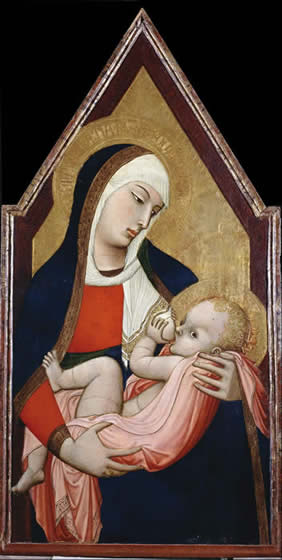INDEX
1. SIENA - MUSEUMS AND PALAZZI
- Oratorio San Bernardino
2. SIENA - CHURCHES
3. PLACES WITHIN HALF AN HOUR OF BARONTOLI
6. SIENESE PAINTERS
7. SAINTS IN ART
One of the most delightful museums in Siena, small enough to avoid cultural indigestion and containing a perfect room and a masterwork of Sienese painting. Despite this, it is very little visited.
In the Piazza San Francesco, to the right of the church. Opening hours keep changing, but the ticket office by the Museum of the OPA (Cathedral Museum) have details (it is one of the five sights that can be visited on a combined ticket along with the Cathedral; Crypt; Baptistery; and Cathedral Museum).
The treats start in the entrance hall with its frescoed ceiling – the 16th century central panel shows Siena’s two most famous saints, San Bernardino and St Catherine of Siena, standing in front of the city, with the Virgin pushed very much to the periphery.
Upstairs, Room 2 is one of the most harmonious artistic ensembles in Siena. In this intimate room where the monks gathered to pray, everything blends successfully together. Benches for the monks line the sides. It has a beautiful carved and gilded ceiling, and on the walls a lovely series of frescoes of the life of the Virgin. Although these are by three contemporary artists of very different styles, Sodoma (1477-1579); Beccafumi (1485-1551); and the lesser known Girolamo del Pacchia (1477 to after 1533), they complement each other admirably, each artist seeming to give of his best. Most of the works were painted in 1588.
Starting with the wall opposite the door, the paintings are from left to right: St Louis by Sodoma; the birth of the Virgin by Pacchia; the presentation of the Virgin at the Temple by Sodoma; the marriage of the Virgin by Beccafumi (note the dream-like quality, dramatic use of colour and intense expressions, quite different from the understated – some would say shallow – charm of Sodoma); and San Bernardino, as toothless as ever, by Pacchia. Over the altar is Beccafumi’s the Virgin and Child with saints, disappointingly grey; and the Annunciation by Pacchia is on either side. On the next wall there is, again from left to right, St Anthony by Sodoma; the Visitation by Sodoma; the death of the Virgin by Beccafumi; the Assumption of the Virgin by Sodoma; and finally St Francis by Sodoma. The end wall has a glorious coronation of the Virgin by Sodoma, full of putti and half-clothed holy personages standing on rather solid clouds.
In Room 3 there is a beautiful alabaster relief of the Virgin and Child and saints, with typical 14th century almond eyes – rather like a Lorenzetti painting transferred to three-dimensional marble.
In Room 4, Il Vecchietta, an artist more usually known for his painting, has turned his hand with immense competence to a polychrome wooden Pietà, stark and naturalistic. Other works in this room include two paintings harking back to the 14th century glory days of Sienese painting: a large gilded Annunciation by the 15th century Matteo di Giovanni, a near copy the much reproduced Annunciation byof Simone Martini in the Uffizi in Florence; and a painted crucifix by Giovanni di Paolo in a by then surely archaic style.
Room 5 houses one of the most perfect of all 14th century paintings, the Madonna del Latte (the nursing Madonna) by Ambrogio Lorenzetti. Everything is right. It is a beautifully balanced composition with clear and harmonious colours. The Virgin looks at the Christchild with an expression of extraordinary mingled tenderness and concern (the Madonna traditionally looks sad as she looks forward to the Passion of Christ); while the Child for his part is for once a natural healthy baby, kicking and pumping at the breast. |
 |
Also in this room there is a faded but still powerful Risen Christ by the other Lorenzetti brother, Pietro, the Christ a haunting figure who has just emerged from his tomb, carrying his shroud over his arm. Opposite for a complete contrast, there is a spirited St George killing the dragon. It was commissioned in 1444 by Giorgio Tolomei (the Tolomei were one of the families who dominated Siena at that period) for the church of San Christoforo. Half-moons decorate the back of the dragon. Experts differ as to what they symbolise. The half-moon was a Tolomei crest, but it seems odd to have one's crest on a dragon, normally seen as a personification of evil. An alternative explanation is that the crest reprersents Islam, which was indeed seen as evil in those crusading days.
By the door there is one of the earliest works of Sienese (and indeed of Western) painting, a Virgin and Child from the beginning of the 1200s, still under strong Byzantine influence, heavily stylised and icon-like. It is by an unknown master from whom only five paintings still remain, one of the others being the Madonna of the Big Eyes in the Museum of the OPA.
Most of the rest of the works in the Oratorio museum can be passed by, but the painting on the landing on the way to Room 6 is worth a look – Christ carrying the cross by Beccafumi; an unadorned scene but with a certain tragic power.
For the neighbouring church, see San Francesco.
Revised 2003